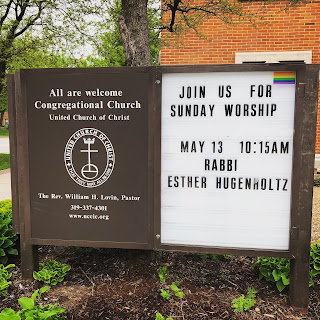The World As It Could Be
Sermon Congregational Church Iowa City
Rabbi Esther Hugenholtz
The World As It Could Be
I would like to invite you to close your eyes and draw a deep breath. Take this moment to center yourself; to remember who you are, created in the Image of God, neither beast nor angel, but made of hope and love. Breathe, and imagine the world as it could be. Take a moment and conjure one image of a better world, a redeemed world.
What image comes to you?
What dream would you dare dream?
The Hebrew Bible is a record of this dream: God’s dream for humanity woven through, from the Garden of Eden to the days of the Prophets. A dream in the forms of whispers and visions, still small voices and roaring flame. Abraham dreamt it as he heard the call to leave his homeland. Moses dreamt it as he confronted Pharaoh in the palace. Deborah dreamt it as she charged into battle. David dreamt it as he strummed his lyre.
Still, the power of this dream lies not in the stories of remarkable individuals but in individual stories that form a remarkable collective testimony.
The singular claim of the Torah lies in the expression of the plural: God redeemed us all out of Egypt, God gave us the Teaching in front of all the people – this is the meaning of ‘Sinai’. God gave all of us the opportunity to dream.
Yesterday, on Shabbat, we read another iteration of this dream. As some of you may know, the Torah is the world’s longest running soap-opera. In the Jewish tradition, we divide the Torah up into a lectionary of 52 weekly readings and read the entire text in yearly cycles, from Genesis to Deuteronomy and back to Genesis. We are currently in the middle of the text, the heart of the Torah: the book of Leviticus. While Leviticus has been much maligned, it is actually an incredible book – a manual for both sanctified and ethical living, seen through the lens of the ancients. Yesterday, we read Chapter 25, which discusses the Sabbatical and Jubilee years, legislating for a societal ‘reset’ button where land is laid to rest, property is redistributed and debts are cancelled.
A plain reading appears to render a dry, legal text, but dig a little deeper and the dream emerges:
“And you shall count for yourself seven sabbatical years, seven years seven times. And the days of these seven sabbatical years shall amount to forty nine years for you. You shall proclaim with the shofar blasts, in the seventh month, on the tenth of the month; on the Day of Atonement, you shall sound the shofar throughout your land.
- ‘V’kidashtem et shanat hachamishit shanah uk’ratem d’ror ba’aretz lechol yoshveiah yovel hi’ - And you shall sanctify the fiftieth year, and proclaim freedom throughout the land for all who live on it. It shall be a Jubilee for you.” (Lev. 25:8-10)
Of course an American listener will resonate deeply with ‘proclaim liberty throughout the land’, the text on the Liberty Bell in Philadelphia.
What does it mean to proclaim liberty throughout the land? To let the land lie fallow and to remit our debt? It is no coincidence that the themes of the Sabbath, the Day of Atonement and Collective Revelation are so intimately interwoven. This text opens with ‘B’har Sinai’, on Mount Sinai. It is a salient detail that could be seen as superfluous, but the attentive student of the Hebrew Bible will know that our text is rarely superfluous.
Chronologically, Revelation happened a book ago, back in Chapter 20 of the Book of Exodus. A lot has happened in between. And yet, the Torah pulls us back in, linking this moment with ‘Matan Torah’, the giving of the Torah. These are not just agricultural laws; they are not even just principles of equitable ethics. No, these are Divinely mandated, written upon our hearts as we witnessed the fire and thunder on the mount.
This is further underscored by the legislation that states that the Jubilee Year should be enacted on the Day of Atonement. Not on Yom Teruah, the first of the seventh month – the Feast of Trumpets, or as we Rabbinic Jews call it, Rosh haShanah. This would have made more sense, seemingly, as it would have been a neat beginning. Instead, the Jubilee is proclaimed on the tenth of the seventh month, when we seek atonement – or better yet, at-one-ment.
Just as we seek remission from sin, cancellation of guilt and liberation from spiritual bondage, so too do we seek remission of property, cancellation of debt and liberation from physical bondage. The Torah teaches us that there is no mind-body dichotomy, that there is no distinction between the concerns of the soul and the needs of the body. There is no conflict between the political and spiritual: on the contrary, to ignore the call for justice, the desire for freedom, the need for rest, is to ignore God’s Self. Social justice is nothing more than applied theology.
The Torah was given in the wilderness so that, in the interpretations of the Rabbis, it was not consigned to any one polity or people, but rather that it was free, for all to acquire. The Torah was given as a great gift, as a profound act of mercy by a loving God, and she was given on a mountain, with fire and smoke, to be a beacon unto the world, a light unto the nations.
Let us continue dreaming that dream, where rest and remission are not utopian luxuries but are the province and guarantee of all human beings. Where we labor towards these aims, so that the weary can find dignity in work and regeneration in rest, so that none of us needs to be crippled by debt and circumscribed by poverty. So that we can all enjoy the blessings of pressing the reset button.
It is this dream that brings our communities together. This coming Sunday, our two great faiths will both have counted fifty days from the onset of Easter and Passover to Pentecost and Shavu’ot, our Feast of Weeks. It is no coincidence that Pentecost draws on the rich symbolism of Shavu’ot: just as we in the Jewish community celebrate the outpouring of our Torah onto the entire people, so too does the Christian community celebrate the outpouring of the Holy Spirit onto the Body of Christ as described in the Acts of the Apostles.
Both covenantal events perpetuate the dream that opens with Genesis 1:27, the bold charge that all human beings are created in the Divine Image, and that ends with the visions of the Prophets, as described by Joel: ‘After that, I will pour out My spirit on all flesh; Your sons and daughters shall prophesy; your old men shall dream dreams, And your young men shall see visions. I will even pour out My spirit upon male and female slaves in those days.’ (Joel 2:28-29)
We are invited, no, we are obligated and commanded to dream the dream, from Eden, to Sinai, to Zion. From all corners of the world where we yearn for the restoration of our souls, respite for our bodies and for redemptive justice. Where we can dream of the world as it could be, should be and perhaps, one day, by the Grace of God, will be.
May God bless the work of our hands, may this be God’s will, amen.



Comments
Post a Comment